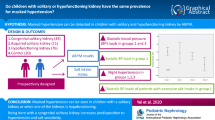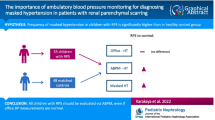Abstract
Background
Children with a solitary functioning kidney are at increased risk of developing chronic kidney disease. Hypertension may be an early indicator of renal dysfunction in these patients. We determined blood pressure (BP) profiles of children with a solitary functioning kidney by using ambulatory BP monitoring (ABPM).
Methods
To assess the occurrence with (pre)hypertension, we compared ABPM to office BP measurement in 47 children with a solitary functioning kidney. None of the subjects used antihypertensive agents or had been hypertensive during previous clinical visits.
Results
Mean age of study subjects was 12.7 (±3.3) years. Hypertension was identified in ten (21 %) subjects with ABPM, whereas only two (4 %) children were hypertensive during office BP measurement (p < 0.01). Fifteen (32 %) children had an ABPM standard deviation (SD) value ≥90th percentile versus six (13 %) subjects based on office BP measurement (p = 0.051). Although 24-h ABPM SD scores were higher in the congenital type than in the acquired type of solitary functioning kidney (p ≤ 0.01), the proportions of subjects with 24-h ABPM hypertension were similar between groups (congenital 25 % versus acquired 16 %; p = NS).
Conclusions
Based on ABPM, one in five children with a solitary functioning kidney has hypertension. As the majority of these subjects were not hypertensive during office BP measurements, ABPM should be considered in the clinical management of solitary functioning kidney patients.

Similar content being viewed by others
References
Sanna-Cherchi S, Ravani P, Corbani V, Parodi S, Haupt R, Piaggio G, Innocenti ML, Somenzi D, Trivelli A, Caridi G, Izzi C, Scolari F, Mattioli G, Allegri L, Ghiggeri GM (2009) Renal outcome in patients with congenital anomalies of the kidney and urinary tract. Kidney Int 76:528–533
Westland R, Kurvers RA, van Wijk JA, Schreuder MF (2013) Risk factors for renal injury in children with a solitary functioning kidney. Pediatrics 131:e478–e485
Westland R, Schreuder MF, van Goudoever JB, Sanna-Cherchi S, van Wijk JA (2013) Clinical implications of the solitary functioning kidney. Clin J Am Soc Nephrol 9:978–986
Brenner BM, Lawler EV, Mackenzie HS (1996) The hyperfiltration theory: a paradigm shift in nephrology. Kidney Int 49:1774–1777
Hostetter TH, Olson JL, Rennke HG, Venkatachalam MA, Brenner BM (1981) Hyperfiltration in remnant nephrons: a potentially adverse response to renal ablation. Am J Physiol 241:F85–F93
Brenner BM, Garcia DL, Anderson S (1988) Glomeruli and blood pressure. Less of one, more the other? Am J Hypertens 1:335–347
O’Brien E, Parati G, Stergiou G, Asmar R, Beilin L, Bilo G, Clement D, de la Sierra A, de Leeuw P, Dolan E, Fagard R, Graves J, Head GA, Imai Y, Kario K, Lurbe E, Mallion JM, Mancia G, Mengden T, Myers M, Ogedegbe G, Ohkubo T, Omboni S, Palatini P, Redon J, Ruilope LM, Shennan A, Staessen JA, van Montfrans G, Verdecchia P, Waeber B, Wang J, Zanchetti A, Zhang Y, European Society of Hypertension Working Group on Blood Pressure Monitoring (2013) European Society of Hypertension position paper on ambulatory blood pressure monitoring. J Hypertens 31:1731–1768
Urbina E, Alpert B, Flynn J, Hayman L, Harshfield GA, Jacobson M, Mahoney L, McCrindle B, Mietus-Snyder M, Steinberger J, Daniels S (2008) Ambulatory blood pressure monitoring in children and adolescents: recommendations for standard assessment: a scientific statement from the American Heart Association Atherosclerosis, Hypertension, and Obesity in Youth Committee of the council on cardiovascular disease in the young and the council for high blood pressure research. Hypertension 52:433–451
Mei-Zahav M, Korzets Z, Cohen I, Kessler O, Rathaus V, Wolach B, Pomeranz A (2001) Ambulatory blood pressure monitoring in children with a solitary kidney—a comparison between unilateral renal agenesis and uninephrectomy. Blood Press Monit 6:263–267
Seeman T, Patzer L, John U, Dusek J, Vondrak K, Janda J, Misselwitz J (2006) Blood pressure, renal function, and proteinuria in children with unilateral renal agenesis. Kidney Blood Press Res 29:210–215
Dursun H, Bayazit AK, Cengiz N, Seydaoglu G, Buyukcelik M, Soran M, Noyan A, Anarat A (2007) Ambulatory blood pressure monitoring and renal functions in children with a solitary kidney. Pediatr Nephrol 22:559–564
Shirzai A, Yildiz N, Biyikli N, Ustunsoy S, Benzer M, Alpay H (2014) Is microalbuminuria a risk factor for hypertension in children with solitary kidney? Pediatr Nephrol 29:283–288
Seeman T (2012) Ambulatory blood pressure monitoring in pediatric renal transplantation. Curr Hypertens Rep 14:608–618
Barletta GM, Flynn J, Mitsnefes M, Samuels J, Friedman LA, Ng D, Cox C, Poffenbarger T, Warady B, Furth S (2014) Heart rate and blood pressure variability in children with chronic kidney disease: a report from the CKiD study. Pediatr Nephrol 29:1059–1065
Westland R, Schreuder MF, Bokenkamp A, Spreeuwenberg MD, van Wijk JA (2011) Renal injury in children with a solitary functioning kidney–the KIMONO study. Nephrol Dial Transplant 26:1533–1541
National High Blood Pressure Education Program Working Group on High Blood Pressure in Children and Adolescents (2004) The fourth report on the diagnosis, evaluation, and treatment of high blood pressure in children and adolescents. Pediatrics 114:555–576
Wuhl E, Witte K, Soergel M, Mehls O, Schaefer F, German Working Group on Pediatric Hypertension (2002) Distribution of 24-h ambulatory blood pressure in children: normalized reference values and role of body dimensions. J Hypertens 20:1995–2007
Schonbeck Y, Talma H, van Dommelen P, Bakker B, Buitendijk SE, Hirasing RA, van Buuren S (2011) Increase in prevalence of overweight in Dutch children and adolescents: a comparison of nationwide growth studies in 1980, 1997 and 2009. PLoS One 6:e27608
Schwartz GJ, Munoz A, Schneider MF, Mak RH, Kaskel F, Warady BA, Furth SL (2009) New equations to estimate GFR in children with CKD. J Am Soc Nephrol 20:629–637
Westland R, Abraham Y, Bokenkamp A, Stoffel-Wagner B, Schreuder MF, van Wijk JA (2013) Precision of estimating equations for GFR in children with a solitary functioning kidney: the KIMONO study. Clin J Am Soc Nephrol 8:764–772
Loftus WK, Gent RJ, LeQuesne GW, Metreweli C (1998) Renal length in Chinese children: sonographic measurement and comparison with western data. J Clin Ultrasound 26:349–352
Rosenbaum DM, Korngold E, Teele RL (1984) Sonographic assessment of renal length in normal children. AJR Am J Roentgenol 142:467–469
Bland JM, Altman DG (1986) Statistical methods for assessing agreement between two methods of clinical measurement. Lancet 1:307–310
Mancia G, Facchetti R, Bombelli M, Grassi G, Sega R (2006) Long-term risk of mortality associated with selective and combined elevation in office, home, and ambulatory blood pressure. Hypertension 47:846–853
Cohen DL, Huan Y, Townsend RR (2013) Ambulatory blood pressure in chronic kidney disease. Curr Hypertens Rep 15:160–166
Chevalier RL (2009) When is one kidney not enough? Kidney Int 76:475–477
Argueso LR, Ritchey ML, Boyle ET Jr, Milliner DS, Bergstralh EJ, Kramer SA (1992) Prognosis of children with solitary kidney after unilateral nephrectomy. J Urol 148:747–751
Argueso LR, Ritchey ML, Boyle ET Jr, Milliner DS, Bergstralh EJ, Kramer SA (1992) Prognosis of patients with unilateral renal agenesis. Pediatr Nephrol 6:412–416
Gonzalez E, Gutierrez E, Morales E, Hernandez E, Andres A, Bello I, Diaz-Gonzalez R, Leiva O, Praga M (2005) Factors influencing the progression of renal damage in patients with unilateral renal agenesis and remnant kidney. Kidney Int 68:263–270
Douglas-Denton R, Moritz KM, Bertram JF, Wintour EM (2002) Compensatory renal growth after unilateral nephrectomy in the ovine fetus. J Am Soc Nephrol 13:406–410
ESCAPE Trial Group, Wuhl E, Trivelli A, Picca S, Litwin M, Peco-Antic A, Zurowska A, Testa S, Jankauskiene A, Emre S, Caldas-Afonso A, Anarat A, Niaudet P, Mir S, Bakkaloglu A, Enke B, Montini G, Wingen AM, Sallay P, Jeck N, Berg U, Caliskan S, Wygoda S, Hohbach-Hohenfellner K, Dusek J, Urasinski T, Arbeiter K, Neuhaus T, Gellermann J, Drozdz D, Fischbach M, Moller K, Wigger M, Peruzzi L, Mehls O, Schaefer F (2009) Strict blood-pressure control and progression of renal failure in children. N Engl J Med 361:1639–1650
Abou Jaoude P, Dubourg L, Bacchetta J, Berthiller J, Ranchin B, Cochat P (2011) Congenital versus acquired solitary kidney: is the difference relevant? Nephrol Dial Transplant 26:2188–2194
Flynn JT, Daniels SR, Hayman LL, Maahs DM, McCrindle BW, Mitsnefes M, Zachariah JP, Urbina EM, American Heart Association Atherosclerosis Hypertension and Obesity in Youth Committee of the Council on Cardiovascular Disease in the Young (2014) Update: ambulatory blood pressure monitoring in children and adolescents: a scientific statement from the American Heart Association. Hypertension 63:1116–1135
Salice P, Ardissino G, Barbier P, Baca L, Vecchi DL, Ghiglia S, Colli AM, Galli MA, Marra G, Testa S, Edefonti A, Magrini F, Zanchetti A (2013) Differences between office and ambulatory blood pressures in children and adolescents attending a hospital hypertension clinic. J Hypertens 31:2165–2175
Acknowledgments
We thank all patients and their parents for participating in the KIMONO study, and Monique Koot for her excellent administrative assistance.
Support
RW is funded by a grant from Fonds Nuts Ohra Zorgsubsidies, Amsterdam, The Netherlands (project number 1101-058).
Author information
Authors and Affiliations
Corresponding author
Electronic supplementary material
Below is the link to the electronic supplementary material.
Fig2
Supplemental figure 1 Bland–Altman plots for (a), systolic blood pressure and (b), diastolic blood pressure. Circles represent systolic BP SD scores, whereas diastolic BP SD scores are displayed by triangles. Mean bias (difference between 24–h ABPM and office BP SD scores) is depicted by the solid line and the 95 % limits of agreement (i.e., mean bias ± 1.96 × SD) are shown by the gray area. ABPM ambulatory blood pressure monitoring; BP blood pressure (GIF 16 kb)
(GIF 17 kb)
Rights and permissions
About this article
Cite this article
Westland, R., Schreuder, M.F., van der Lof, D.F. et al. Ambulatory blood pressure monitoring is recommended in the clinical management of children with a solitary functioning kidney. Pediatr Nephrol 29, 2205–2211 (2014). https://doi.org/10.1007/s00467-014-2853-0
Received:
Revised:
Accepted:
Published:
Issue Date:
DOI: https://doi.org/10.1007/s00467-014-2853-0




